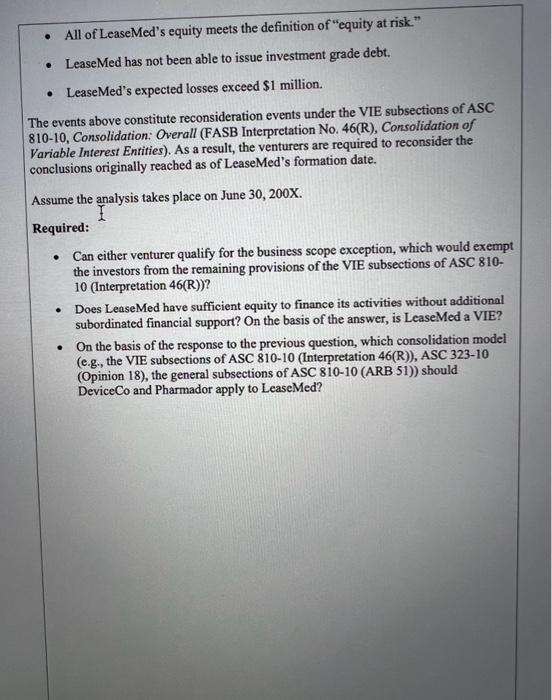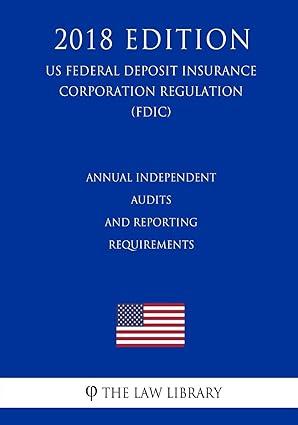please answer the following questions:
1. Is LeaseMed a VIE and why?
2. who is the primary beneficiary, if any.
3. please answer the last question on the second page, which consolidation model should DeviceCo and Pharmador apply to LeaseMed?

Venturing Into Consolidations DeviceCo, a manufacturer of small-scale medical equipment, formed a joint venture (JV) with Phamador on January 1,200X. Pharmador is a large pharmaceutical company that is seeking to enter into the medical equipment business. The JV, LeaseMed, a newly formed business with no existing operations, plans to lease large-scale medical equipment (e.g., large diagnostic equipment) to U.S. hospitals. LeaseMed plans to acquire the equipment to be leased from a manufacturer unrelated to either DeviceCo or Pharmador (collectively, the venturers). The venturers have no relationship with each other aside from this JV. At formation, LeaseMed is in the process of collecting regulatory permits and licenses to enter the medical equipment leasing business and, thus, is a developmentstage entity. The board of directors (the Board) has six members: three representatives for DeviceCo and three representatives for Pharmador. Board approval is required for ongoing business activities (c.g., selecting, terminating, and setting the compensation of management) and approval of all new contracts in excess of $50,000, including thrse with new vendors and customers. All Board decisions require a majority vote. Neither venturer has any additional involvement with LeaseMed (i.e., no management contracts, service contracts, leases). LeaseMed exhibits all of the characteristics of a JV under joint control. LeaseMed is formed with initial cash contributions of $55,000 from DeviceCo and $45,000 from Pharmador. Ownership, as well as profits and losses, are divided accordingly (55:45). At formation, LeaseMed was a variable interest entity (VIE) and DeviceCo consolidated LeaseMed as its primary beneficiary. All three companies have a December 31 year end. Between January 1, 200X, and June 30, 200X, the following events occur: LeaseMed secures the necessary licenses and permits. LeaseMed hires 5,000 employees, originates a leasing portfolio, and generates significant revenue. Including the equity provided at formation, DeviceCo and Pharmador have contributed a combined total of $1 million to LeaseMed, according to their ownership percentages (DeviceCo contributed $550,000, and Pharmador contributed $450,000 ), The primary risk that creates variability in LeaseMed is operations risk. LeaseMed is designed to pass this variability to the equity holders proportionately on the basis of their ownership interests. Other relevant facts: - Both venturers have determined that substantially all of the activities of LeaseMed do not involve or are not conducted on behalf of either venturer. - All of LeaseMed's equity meets the definition of "equity at risk." - LeaseMed has not been able to issue investment grade debt. - LeaseMed's expected losses exceed \$1 million. The events above constitute reconsideration events under the VIE subsections of ASC 810-10, Consolidation: Overall (FASB Interpretation No. 46(R), Consolidation of Variable Interest Entities). As a result, the venturers are required to reconsider the conclusions originally reached as of LeaseMed's formation date. Assume the analysis takes place on June 30,200X. Required: - Can either venturer qualify for the business scope exception, which would exempt the investors from the remaining provisions of the VIE subsections of ASC 81010 (Interpretation 46(R) )? - Does LeaseMed have sufficient equity to finance its activities without additional subordinated financial support? On the basis of the answer, is LeaseMed a VIE? - On the basis of the response to the previous question, which consolidation model (e.g., the VIE subsections of ASC 810-10 (Interpretation 46(R)), ASC 323-10 (Opinion 18), the general subsections of ASC 810-10 (ARB 51)) should DeviceCo and Pharmador apply to LeaseMed









